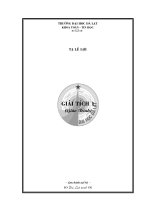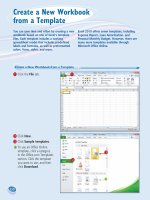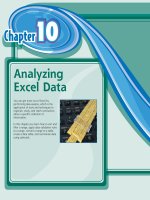Tài liệu Constituent Structure - Part 1 pptx
Bạn đang xem bản rút gọn của tài liệu. Xem và tải ngay bản đầy đủ của tài liệu tại đây (162.39 KB, 10 trang )
Constituent Structure
OXFORD SURVEYS IN SYNTAX AND MORPHOLOGY
general editor: Robert D. Van Valin, Jr, Heinrich-Heine Universita
¨
tDu
¨
sseldorf
& University at BuValo, State University of New York
advisory editors: Guglielmo Cinque, University of Venice; Daniel Everett,
Illinois State University; Adele Goldberg, Princeton University; Kees Hengeveld,
University of Amsterdam; Caroline Heycock, University of Edinburgh; David
Pesetsky, MIT; lan Roberts, University of Cambridge; Masayoshi Shibatani,
Rice University; Andrew Spencer, University of Essex; Tom Wasow, Stanford
University
published
1. Grammatical Relations
Patrick Farrell
2. Morphosyntactic Change
Olga Fischer
3. Information Structure: the Syntax-Discourse Interface
Nomi Erteschik-Shir
4. Computational Approaches to Syntax and Morphology
Brian Roark and Richard Sproat
5. Constituent Structure
Andrew Carnie
in preparation
The Acquisition of Syntax and Morphology
Shanley Allen and Heike Behrens
The Processing of Syntax and Morphology
Ina Bornkessel-Schlesewsky and Matthias Schlesewesky
Morphology and the Lexicon
Daniel Everett
The Phonology–Morphology Interface
Sharon Inkelas
The Syntax–Semantics Interface
Jean-Pierre Koenig
Complex Sentences
Toshio Ohori
Syntactic Categories
by Gisa Rauh
Language Universals and Universal Grammar
Anna Siewierska
Argument Structure: The Syntax–Lexicon Interface
Stephen Weschler
Constituent
Structure
ANDREW CARNIE
1
3
Great Clarendon Street, Oxford ox2 6dp
Oxford University Press is a department of the University of Oxford.
It furthers the University’s objective of excellence in research, scholarship,
and education by publishing worldwide in
Oxford New York
Auckland Cape Town Dar es Salaam Hong Kong Karachi
Kuala Lumpur Madrid Melbourne Mexico City Nairobi
New Delhi Shanghai Taipei Toronto
With oYces in
Argentina Austria Brazil Chile Czech Republic France Greece
Guatemala Hungary Italy Japan Poland Portugal Singapore
South Korea Switzerland Thailand Turkey Ukraine Vietnam
Oxford is a registered trade mark of Oxford University Press
in the UK and in certain other countries
Published in the United States
by Oxford University Press Inc., New York
ß Andrew Carnie 2008
The moral rights of the author have been asserted
Database right Oxford University Press (maker)
First published 2008 by Oxford University Press
All rights reserved. No part of this publication may be reproduced,
stored in a retrieval system, or transmitted, in any form or by any means,
without the prior permission in writing of Oxford University Press,
or as expressly permitted by law, or under terms agreed with the appropriate
reprographics rights organization. Enquiries concerning reproduction
outside the scope of the above should be sent to the Rights Department,
Oxford University Press, at the address above
You must not circulate this book in any other binding or cover
and you must impose the same condition on any acquirer
British Library Cataloguing in Publication Data
Data available
Library of Congress Cataloging in Publication Data
Data available
Typeset by SPI Publisher Services, Pondicherry, India
Printed in Great Britain
on acid-free paper by
Biddles Ltd., King’s Lynn, Norfolk
ISBN 978–0–19–926199–4 (Hbk.)
978–0–19–926200–7 (Pbk.)
13579108642
Contents
Acknowledgements x
General Preface xi
Abbreviations xii
Symbols Used xvi
Part 1. Preliminaries
1. Introduction 3
1.1. What this book is about 3
1.2. Organizational notes 4
1.3. Apples, oranges, and pears 5
1.4. Who I assume you are 7
2. Constituent Structure 8
2.1. Constituent structure as simple concatenation 8
2.2. Regular grammars 12
2.3. Constituent structure and constituency tes ts 17
2.4. Compositionality, modiWcation, and ambiguity 21
2.5. Some concluding thoughts 24
3. Basic Properties of Trees: Dominance and Precedence 25
3.1. Introduction 25
3.2. Tree structures 26
3.3. Dominance 29
3.3.1 Simple dominance 29
3.3.2 Axiomization of dominance 30
3.3.3 Immediate dominance 35
3.
3.4 Exhaustive dominance and ‘‘constituent’’ 36
3.4. Precedence 37
3.4.1 Intuitive characterizations of precedence 37
3.4.2 Immediate precedence 41
3.4.3 Axioms of precedence 41
3.5. Concluding remarks 44
4. Second Order Relations: C-command and Government 46
4.1. Introduction 46
4.2. Command, kommand, c-command, and m-command 46
4.2.1 Command and kommand (cyclic command) 47
4.2.2 C-command (constituent command) 49
4.2.3 Deriving and explaining c-command 55
4.2.4 M-command 58
4.2.5 Barker and Pullum (1990): A uniWed approach to
command relations 60
4.3. Government 63
4.4. Concluding remarks 65
Part 2. Phrase Structure Grammars and X-bar Theory
5. Capturing Constituent Structure: Phrase Structure
Grammars 69
5.1. Before the Chomskyan revolution: ConXating semantic
and structural relations 69
5.2. Phrase structure grammars 71
5.3. Phrase markers and reduced phrase markers 78
5.4. Regular grammars; context-free and context sensitive
grammars 80
5.4.1 Regular grammars 81
5.4.2 Context-free and context-sensitive
phrase structure grammars 83
5.5. The recursive nature of phrase structure grammars 84
5.6. The ontology of PSRs and trees 86
5.7. The information contained in PSRs 90
6. Extended Phrase Structure Grammars 93
6.1. Introduction 93
6.2. Some minor abbreviatory conventions in PSGs 94
6.3. Transformations 96
6.3.1 Structure-changing transformations 96
6.3.2 Generalized transformations 97
vi contents
6.4. Features and feature structures 98
6.4.1 The use of features in Generalized Phrase
Structure Grammar 100
6.5. Metarules 103
6.6. Linear Precedence vs. Immediate Dominance Rules 105
6.7. Meaning postulates (GPSG), f-structures and
metavariables (LFG) 106
6.7.1 Meaning postulates in GPSG 106
6.7.2 Functional equations, f-structures, and
metavariables in LFG 107
6.7.3 Summary 110
6.8. The lexicon 110
6.9. Conclusion 111
7. X-bar Theory 112
7.1. Introduction 112
7.2. Simple PSGs vs. X-bar theoretic PSGs 112
7.2.1 Headedness 112
7.2.2 Structural reWnement 114
7.2.3 Binarity 120
7.2.
4 Distinctions among modiWer types 121
7.2.5 Cross-linguistic variation 128
7.2.6 Summary 129
7.3. A short history of X-bar theory 129
7.3.1 The origins: Harris (1951) and Chomsky (1970) 129
7.3.2 Early controversies: Emonds (1976), JackendoV
(1977), Stuurman (1984) 130
7.3.3 A major conceptual shift: metagrammar
vs. grammar: Stowell (1981) 131
7.4. Summary 132
Part 3. Controversies
8. Towards Set-Theoretic Constituency Representations 135
8.1. Introduction 135
8.2. Projections and derived X-bar theory 136
contents vii
8.3. Antisymmetry 144
8.3.1 The LCA and linear ordering 145
8.3.2 Deriving some X-bar theoretic properties
from the LCA 149
8.3.3 Adjunction 150
8.4. Bare Phrase Structure 154
8.4.1 The basics of BPS 155
8.4.2 Adjunction in BPS 158
8.4.3 Bottom-to-top and top-to-bottom derivations 160
8.4.3.1 Bottom-to-top derivations 161
8.4.3.2 Top-to-bottom derivations 161
8.4.4 Derived X-bar theory 163
8.4.5 Label-free and projection-free structures 167
9. Dependency and Constituency 168
9.1. Introduction 168
9.2. Systems based primarily on grammatical relations 171
9.2
.1 A semi-arboreal system: Lexical-Functional
Grammar 171
9.2.2 Relational Grammar 172
9.3. Dependency grammars 175
9.4. Categorial grammars 178
9.4.1 Classic Categorial Grammar and Combinatorial
Categorial Grammar 179
9.4.2 Tree-Adjoining Grammar (TAG) 183
9.4.3 Features in HPSG 185
9.5. Functionalist Grammar and Role and Reference
Grammar 186
9.6. Construction Grammar and Cognitive Grammar 187
10. Multidominated, Multidimensional, and
Multiplanar Structures 189
10.1. Introduction 189
10.2. Line crossing and multidomination: axiomatic
restrictions on form 195
viii contents
10.2.1 The non-tangling–exclusivity controversy 195
10.2.2 C-command and the non-tangling condition 200
10.3. Multidomination and multidimensional trees 204
10.4. Multiplanar structures 207
10.4.1 Parallel plane hypotheses: Classic
Transformational Grammar, LFG,
Simpler Syntax 208
10.4.2 The Parallel Plane hypotheses: L- and S-Syntax
and pheno- and tectogrammatical structures 209
10.4.3 Wheel-and-spoke multiplanar approaches 212
10.5. Conclusions 217
11. Phrasal Categories and Cartography 219
11.1. Introduction 219
11.2. The tripartite structure of the clause 221
11.3. The VP 222
11.3.1 Classic constituency tests 223
11.3.2 VSO languages as evidence against VPs 226
11.3.3 The VP-internal subject Hypothesis (VPISH) 234
11.3.4 Stacked VPs, Split VPs, vP 237
11.4
. The clausal layer 242
11.5. The informational layer 250
11.5.1 S’ and CP 251
11.5.2 Expanded CP 253
11.6. Negation and adver bials 256
11.6.1 Negation 256
11.6.2 Adverbs 258
11.7. NPs and DPs 259
11.8. Concluding remarks 260
References 261
Index 287
contents ix









